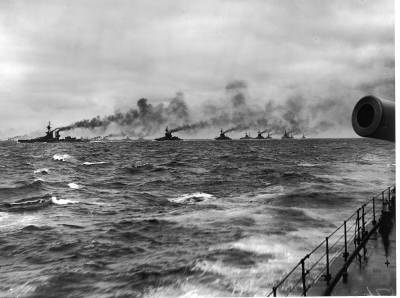The Battle of Jutland: 100 years on – Ben Barker
This year marks the centenary of the Battle of Jutland (May 31st – June 1st, 1916), which saw 101 former RHS pupils lose their lives in little more than 12 hours – an unprecedented scale and rate of alumni loss. The battle was fought in the North Sea, 60 miles off the coast of Jutland, Denmark, and was the largest naval engagement of the First World War. Indeed, it is one of the biggest in all of history, and its significance is still a hotly debated topic.
For much of the First World War, the Royal Navy placed a blockade on German ports. It was its intention to stop supplies from reaching Germany and thereby starve the Germans into submission and surrender. The Germans needed to defeat the blockade by inflicting heavy losses on the Royal Navy. At the time of the battle, the commanders of the British and German navies were Sir John Jellicoe (later Earl Jellicoe) and Admiral Reinhard Scheer, respectively. Because the German Navy was smaller in numbers than the Royal Navy, Scheer’s strategy was to lure out and destroy portions of the British Grand Fleet, reducing its strength gradually, rather than engaging the entirety of the British Navy in open combat. Jellicoe’s strategy was to preserve his superior numbers and thus his ability to maintain the blockade.
The German plan at Jutland was for the German Vice-Admiral Franz Hipper’s fast scouting battle cruisers to lure Vice-Admiral Sir David Beatty’s battle cruiser squadron south into the path of Germany’s main fleet, which would then crush Beatty’s squadron with their numerical superiority. However, the British suspected a German attack, and the entire Grand Fleet was also at sea. As Hipper intended, Beatty chased and engaged the German battlecruisers, sustaining the loss of two ships and enormous casualties. Just in time, he sighted the rest of the German High Seas Fleet sailing towards him; by turning around and fleeing north, he just managed to avoid their trap. The position was now reversed: the main German fleet was pursuing Beatty’s force, but directly into the path of the British Grand Fleet, which Scheer was unaware was at sea. A hugely complex engagement involving 250 ships – 151 British and 99 German – then followed, which saw enormous acts of bravery and self-sacrifice on both sides, culminating in a vicious night action during which Scheer managed to disengage and escape back to the safety of German ports in the early hours of June 1st.
Despite their numerical superiority, British losses were heavier than the Germans’: 6,094 sailors and 113,300 tons of ships on the British side against 2,551 sailors and 62,300 tons on the Germans’. Both sides claimed victory but the battle was had no clear victor. Jutland was probably a narrow German tactical victory – they had, after all, inflicted heavier losses on the enemy – but a vindication of British strategy: they recovered their losses quickly, retained control of the North Sea and maintained the blockade of German ports which, by 1918, saw Germany on the point of collapse. The British public and admiralty, expecting a second Trafalgar, were disappointed, and Jellicoe’s careful approach was compared unfavourably with Beatty’s dash and flair. His caution, however, was justified. As Winston Churchill said, “Jellicoe is the only man on either side who could lose the war in an afternoon” – he could not justify risking a catastrophic defeat in the pursuit of a strategically unnecessary victory.











1 comment